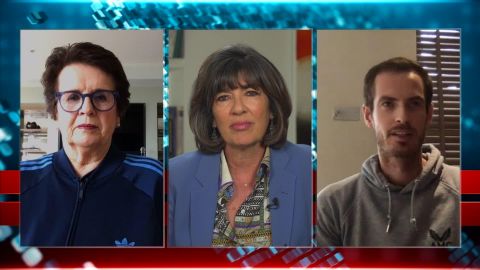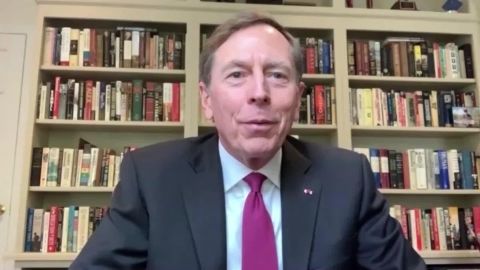Read Transcript EXPAND
WALTER ISAACSON: General David Petraeus, thank you for so much for joining us.
GEN. DAVID PETRAEUS, FORMER COMMANDER COALITION FORCES IN IRAQ AND AFGHANISTAN: Great to be with you. Thanks, Walter.
ISAACSON: You have talked often about the principles of strategic leadership. What are those principles and how do they apply to this case?
PETRAEUS: Well, I think there are four tasks of a strategic leaders. And in this setting, certainly the strategic leaders would include the president, those in Congress, the fed and the governors as well given a federal system that we have. And the four tasks to get the big ideas right. And by and large, I think that there has been convergence around these big ideas about what to do even as we are racing to develop a vaccine and a therapeutic treatment. Second, to communicate the big ideas and the progress in implementing them to the population so that they know the status, they know what we still need them to do and they know how to go about activities as safely as is absolutely possible. To oversee the implementation of the big ideas is the third task and this involved everything from the metrics, which have to be absolutely forthright and grounded in data, the example that’s provided, the energy, the inspiration, the driving of the campaign plan which would include, first and foremost I think, the dramatic increase in testing and the dramatic increase required in contact tracing. And then the final task that is sometimes overlooked which — and generally formally has to be done, which is to sit down and determine how the big ideas need to be refined, augmented, whatever, so they can to do it again and again and again. Because we’re going to learn from the early experiences of states that are beginning to take small steps back to economic recovery and we’re going to learn whether or not they should do that even if they haven’t had the 14 days of the down trend that is a feature of the White House proposal and one of the governors and Harvard. So, that’s the process, I think, of strategic leadership. And I think that, again, having arrived at these big ideas, the challenge now is to make sure that everyone understands them, that you have sort of a relentless communication of what these big ideas are and then an even more relentless oversight of the execution of them.
ISAACSON: You talk about relentlessly communicating with clarity. Do you think we’ve been effective at communicating clearly about things like should you wear a mask, how do you get testing, what type of testing we need to do or do you think there are ways to improve the single messages we should be trying to get out?
PETRAEUS: Well, I think there’s always room for improvement in whatever endeavor you’re engaged in. I’m sure that we will look back and see that there have been cases where there have been deviations from the single- minded emphasis on the steps that need to be taken, while also acknowledging, Walter, that in a federal system that has 50 states with big differences between them, in a number of situations, I mean, the dispersion of the population in a western state compared with the density of that population, say, in Southern New York and New Jersey is very, very striking. And, therefore, there will be some differences in how the reduction of the restrictions plays out.
ISAACSON: So, what message should the American people take from the fact that the president has said he won’t wear a mask, the vice president didn’t wear it at the hospital?
PETRAEUS: Well, I hope the message is not that they shouldn’t wear a mass income a public place. That, for example, if you’re riding the subway in New York or on crowded streets should they become crowded again or in other situations where you can’t maintain the physical distancing that we have all now memorized at six feet or further, that you shouldn’t actually do what it is that they are doing, perhaps ideally I hope founded on some data that they’re being tested frequently and there’s enormous safeguards and the rest of this. But at the end of the day, again, strategic leaders get paid to provide example as well as all of these other actions when it comes to overseeing the execution of the big ideas that we have discussed in which they are the ones, of course, who put those out to the U.S. public.
ISAACSON: Do you see an overarching strategy at work?
PETRAEUS: Well, I do. Again, as I have described, the White House framework, I think, is very solid. In fact, if you look at the National Governor Association approach, they actually compare and contrast every single one of the different significant proposals that is out there. And they’re all roughly, again, the same. They all involve initially breaking community transmission by essentially the lockdown that we have all been experiencing, and then, when the data shows you certain indicators — and these are the metrics. And, again, you live and die by metrics, just as we did in the combat zone. We have got to follow the data. And we have to adhere to, again, the guidelines, certainly modified for the states and municipalities and their conditions, but take the actions, if and only if you have seen 14 down days, and then you go to the next step, and then 14 more of the next, and so forth, until you are largely back at what used to be normal, noting that there is going to be a new normal, and that I do think that business and consumer and citizen behavior will change, some of it, in certain respects, forever, as a result of this terrible pandemic experience we’re going through.
ISAACSON: But aren’t most of the governors totally frustrated that they don’t have the testing facilities that they need?
PETRAEUS: It certainly seems to be that, in a bipartisan basis, I think it’s accurate to say that, again, Democratic and Republican governors have stated that they would like to have more assistance with testing. Now, again, to be fair, this is very, very hard government work, as we say, to dramatically increase this, and noting that a lot of the materials for these testings and the various equipment involved is not produced in the United States. There’s a huge reliance, of course, on Chinese manufacturing and a lot of these different ways. And there was also a huge reliance on what was called just-in-time logistics, where you don’t want to have huge warehouses, because that all costs money, and just as businesses have in some other cases, have slimmed down the warehouse contents, because there’s a confidence that, in a crisis, you can just have them deliver more and more rapidly than what is normally the case. And, of course, if it’s a global crisis, everybody is shut down, and that particular approach demonstrates certain vulnerabilities and challenges.
ISAACSON: Is the administration using the Defense Production Act effectively, in your opinion, or should we be taking an approach more like we did in World War II?
PETRAEUS: That’s a tough question. Obviously, it has been used, I think it’s just twice formally. But the threat of it has also been used. And I think that’s been used to reasonably good effect. But, again, at the end of the day, Walter, it’s not a subjective judgment that should guide us here. It’s actually, as my father used to say whenever I would bring home a report card, results, boy. And it was same in Iraq. I remember my great mentor, General Keane, coming out to Iraq. We’re at about month five. And, actually, we are starting to see a positive trend, but it’s still too early. And he tells me — he said, you know, you have a public relations challenge here. And I said, we don’t have a public relations challenge. We have a results challenge. And, again, what should tell us how we’re doing is whether or not we ultimately get to whatever is determined should be the goal for national testing. And, again, if it’s five million tests per day, which, again, would be something like 15 to 20 times a good day right now, that should be the metric against which we are competing.
ISAACSON: You say that one of the most important things to do now is a massive surge in testing, and that we should have a coordinated effort to throw everything at that. Do you think that’s happening?
PETRAEUS: I think there is that recognition. I think, look. I mean, it was a press conference yesterday or the day before that had all of the individuals that produce these kind of tests, not all, but a subset of them, once back on stage in the Rose Garden. So, again, that’s clearly that recognition. Then the question is, are those who are in charge of driving this campaign, because make no mistake about it, you know, a commander may try to look as if he has a light hand on the reins and all he’s doing is just sort of patting people on the back and they’re doing great work. You drive a campaign. The surge in Iraq, we drove. General Odierno and I drove that surge, with McChrystal and others. Again — and you absolutely throw everything at that. And you don’t let obstacles stand in your way, if you can prevent it.
ISAACSON: But do you feel that that’s what’s happening now, that that’s what our leaders are doing?
PETRAEUS: It’s — this is a tough one for me to judge, Walter. Again, I’m not in the counsels of these — again, of the task force and the others. I’m not aware of all of the instructions that have gone out. I don’t have the projections and, again, the hard data right now. But, again, certainly right now, I mean, what is, I think, undeniable is that we do not have the level of testing that every single one of the programs either specifies or suggests is required ultimately to, with confidence, allow people to reduce some of the restrictions under which we’re currently operating.
ISAACSON: President Trump calls himself a wartime president. Tell me what you think the attributes of a wartime president should be.
PETRAEUS: I think that wartime or peacetime — but, of course, there’s a certain urgency to leadership in wartime, but you come back again to the four tasks of a strategic leader, getting the big ideas right. It’s usually an inclusive, transparent, open, iterative process. No one of us is smarter than all of us together. Developing the big ideas, then communicating them, and doing that relentlessly. And, again, the measure is, how well does someone perform each of those different tasks? And that’s the question that I think, again, it is fair for a country to ask about its leader, about its Congress, about its Federal Reserve chief, Treasury secretary, the other prominent players, CDC and the HHS. And it’s there for citizens of states and cities to ask the same about their leaders.
ISAACSON: President Trump has said that he — quote — “bears no responsibility” for this. As a commander, how do you balance the notion of saying the buck stops with me, taking responsibility for things, with the need to keep people still having faith in what you’re doing?
PETRAEUS: Well, look, I grew up in a profession and served in that profession for over 37 years and over 38-and-a-half in government overall. And the description of your responsibilities as a commander was that you are responsible for all that your unit does or fails to do. Now, obviously, you look at, when you’re evaluating a commander, for example, and you see that there has been some problem or challenge or they came up short on something or did fantastically on something. It is not always because of the commander. It is obviously always a team effort. So, in that sense, you have to factor in what else is going on. But, at the end of the day, that particular thinking seemed inescapable for me, and I think probably is a reasonable example of the kind of accountability that should go with the awesome responsibility that comes from command from executive positions.
ISAACSON: Have you spoken to President Trump about this?
PETRAEUS: No. I should note I have spoken to members of the White House, some that are of fairly significant rank, several of them. And they have welcomed input. They haven’t necessarily applauded every single bit of advice or recommendations that I have made. But, by and large, they have been appreciative of me making that, providing that input.
ISAACSON: Do you think it would be useful to have a full-time commander, like a general, in charge of this on a day-by-day, hour-by-hour basis?
PETRAEUS: Look, I think you have a task force. It’s led by the vice president. The president clearly is heavily involved in this. There are subordinate task forces of various types. The challenge, of course, is, how do you drive this to the next level? And that is, I think, the major question right now when it comes to significantly and dramatically increasing testing and contact tracing capabilities.
ISAACSON: And, finally, what have you learned, as a wartime commander and a joint commander of many forces under your control, that would apply to this fight against coronavirus?
PETRAEUS: I think what you learn as a combat commander, if it’s in Iraq or Afghanistan or the greater Middle East, what have you, is the imperative, again, of getting the strategy right. Please recall that the surge in Iraq that mattered most wasn’t the surge of forces. It was a surge of ideas. It was a change in strategy, and then that you have to work very hard to communicate those big ideas through the breadth and depth of the organization, and then relentlessly oversee the implementation of those big ideas, working very hard to set up your subordinate commanders for success, and to get everything you possibly can for them, so that they have the best possibility of achieving success, without ever forgetting to sit down formally — we used to do it in Baghdad — and determining how you need to change, to refine, to augment the big ideas, so that you do it again and again and again.
ISAACSON: General Petraeus, thank you so much for joining us.
PETRAEUS: My pleasure. Thanks, Walter.
About This Episode EXPAND
Christiane speaks with tennis stars Billie Jean King and Andy Murray about gender equality and the pandemic’s impact on their sport. She also speaks with documentary filmmaker Ken Burns about what history can teach us in these challenging times. Walter Isaacson speaks with General David Petraeus about how wartime lessons can be applied to fighting a pandemic.
LEARN MORE


